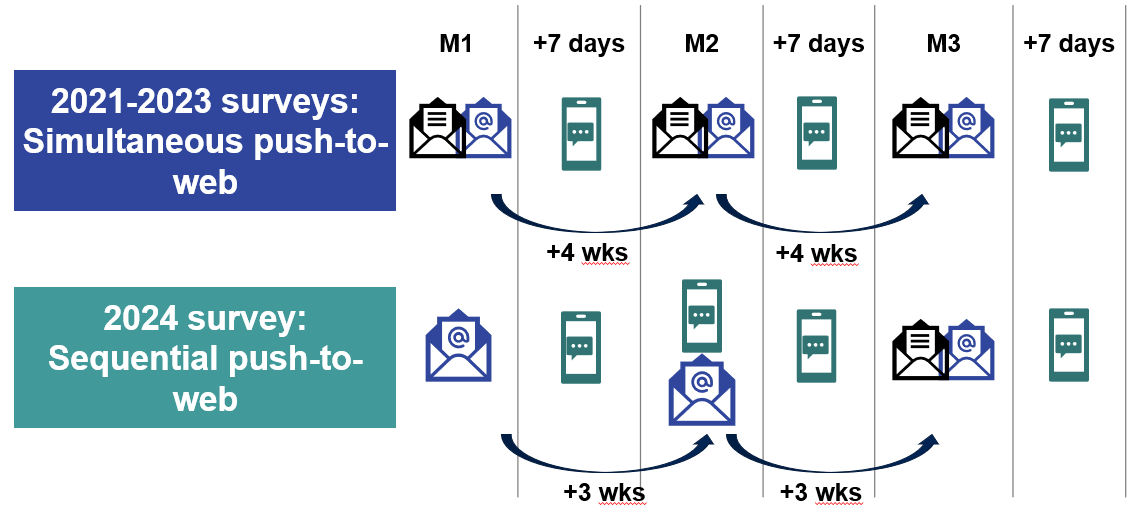Changes to the GP Patient Survey
1. Questionnaire changes
The GPPS questionnaire was redeveloped ahead of the 2024 survey to reflect how primary care services are delivered and patients experience them. Previous survey results show that services need to change to improve patient access and better align with patient priorities. The publication of the Fuller Stocktake and the Delivery Plan for Recovering Access to Primary Care set out key changes in response, including implementing modern general practice access alongside other key initiatives for making it easier for patients to get the help they need and expanding the role of pharmacy services. More detail can be found on the NHS England website.
These changes are expected to benefit patients and their experience of primary care services, and to ensure that the GPPS remains relevant in this context, it was essential to review and update the questionnaire.
This also provided the opportunity to improve other areas of the questionnaire, for example, ensuring that where possible, demographic questions are aligned with other major NHS patient experience surveys and the ONS harmonised standards. And all remaining existing questions were reviewed to ensure that they were understood and answered as expected by participants. This resulted in changes to question wording and response codes across the whole questionnaire.
Please note, even for those individual questions where the wording has remained the same as in previous years, analysis has shown that trends cannot be reliably presented due to context effects.
The 2024 questionnaire and a report which details the re-development process are available on the GPPS website.
2. Methodology changes
Sampling strategy
The 2024 survey used the same sampling approach as the 2023 survey.
Mailing strategy
The GPPS methodology has historically used a simultaneous push-to-web approach, offering the option to take part online and a paper questionnaire in every mailing. From 2024 onwards, the contact strategy for GPPS has changed to a sequential push-to-web methodology. This was a result of a series of experiments conducted in 2022 and 2023 which demonstrated that it was possible to save a significant amount of money by removing a paper questionnaire from the first two mailings and, where a mobile phone number was available, to replace the second physical mailing with an e-letter.
Analysis of these experiments showed that while there was no significant impact on the demographic profile of patients taking part in the survey, there were significant differences in answers to key survey questions. For example, patients in the experiment group reported poorer experiences, were more likely to have avoided making an appointment (because it was too difficult and overall) and were more likely to have used online services. This indicated that moving to a sequential push-to-web approach would result in a break in trends across the survey results as a whole.
Overview of simultaneous and sequential push-to-web approaches used on GPPS

More details of these experiments can be found in the 2022 and 2023 technical annex, and copies of the updated materials used for 2024 fieldwork can be found on the 2024 surveys and reports page.
3. Reporting
Accessibility review
We reviewed the accessibility of all reporting outputs for the 2024 survey. The main changes we made were:
-
Offering the note on changes to the survey (this note) and the technical annex in HTML format as this is more accessible to screen-readers. A Word/PDF document is also available to download;
-
the Excel reports have been re-designed to reduce the number of merged cells and adjust cell alignment; and
-
other outputs have been made more accessible through changes made to formatting (e.g. National Report).
A mix of data visualisation and table outputs offers access to less technical readers whilst providing the opportunity for additional analysis. Signposting is designed to help users find the best output for them, according to their needs.
4. Organisational changes
Organisational changes reference changes to NHS organisational structures as well as detailing known changes in GP practice alignment to ICSs (as of April of each year). Published data is presented under the organisation name that was current at the end of fieldwork, April 2024.
Practice level ICS changes
GP practice information is taken from the NHS Digital Organisation Data Service “epraccur” reference file. In cases where practices have closed before the implementation of higher geography changes, the file can map practices to organisations (e.g. regions and ICSs) that no longer exist. Where this is the case, the ICS and region for these practices is updated to reflect the current NHS commissioning structures, as of April in the relevant survey year.
This year there have been no changes to ICS level boundaries, and all practices continue to be aligned with the same ICS.


